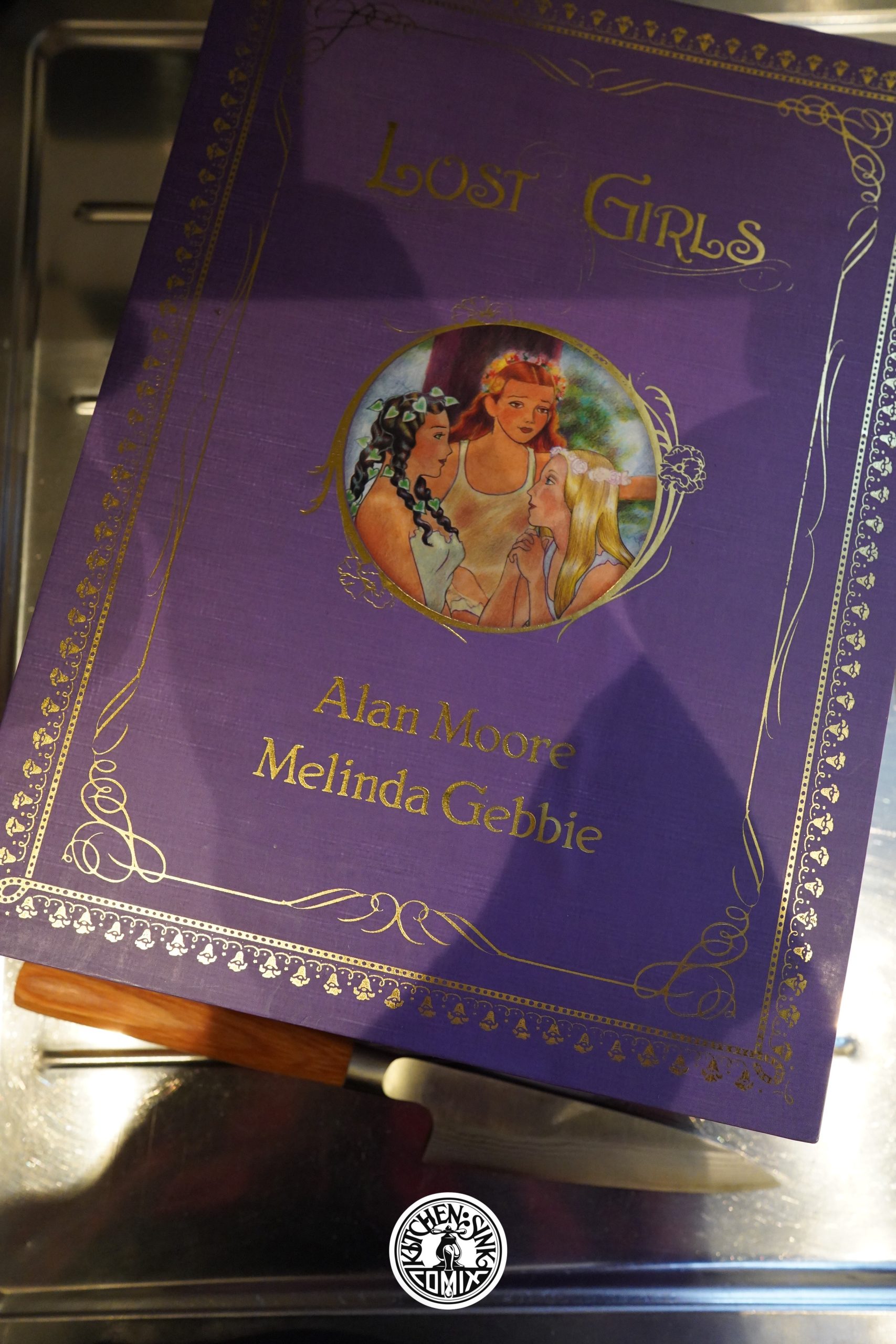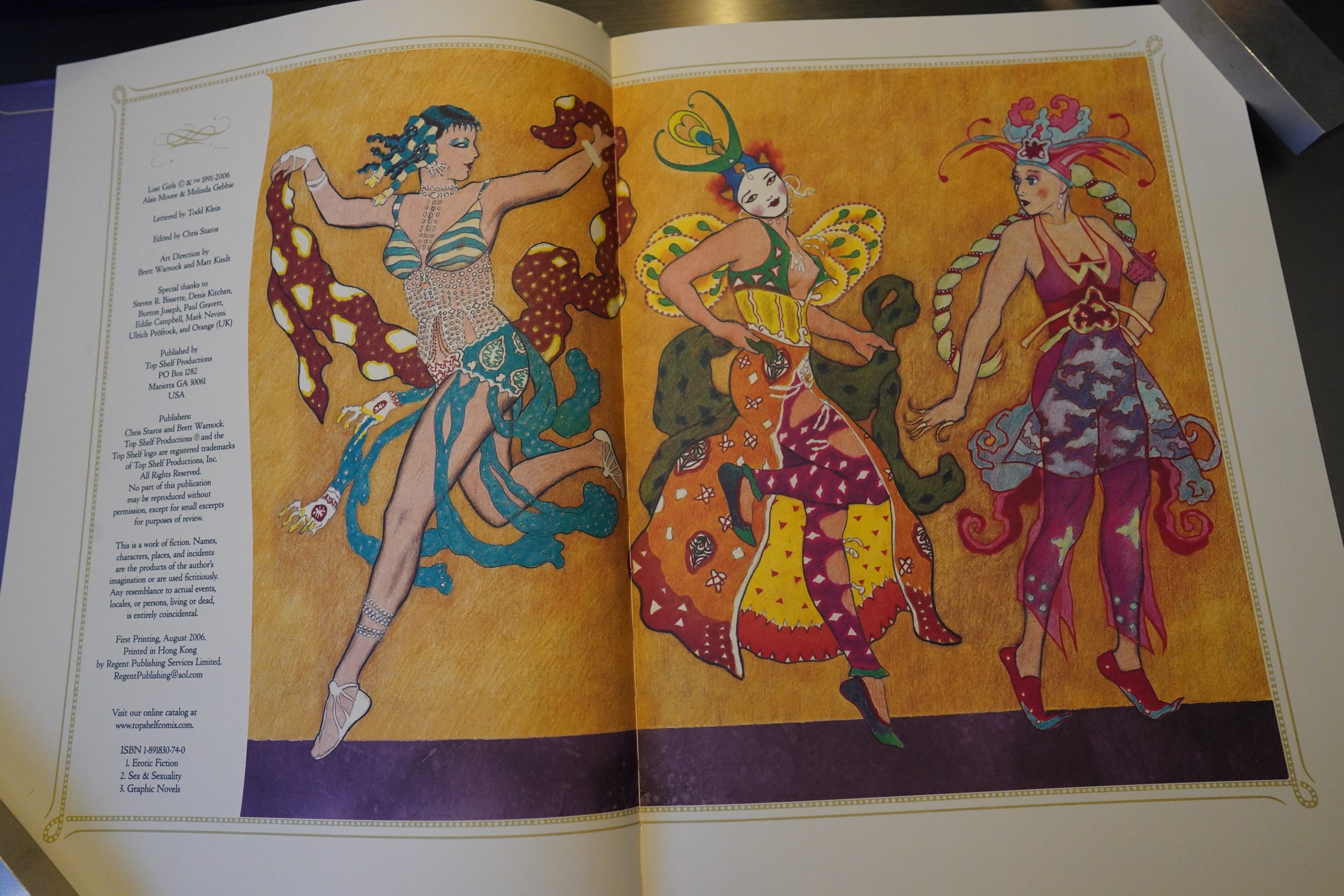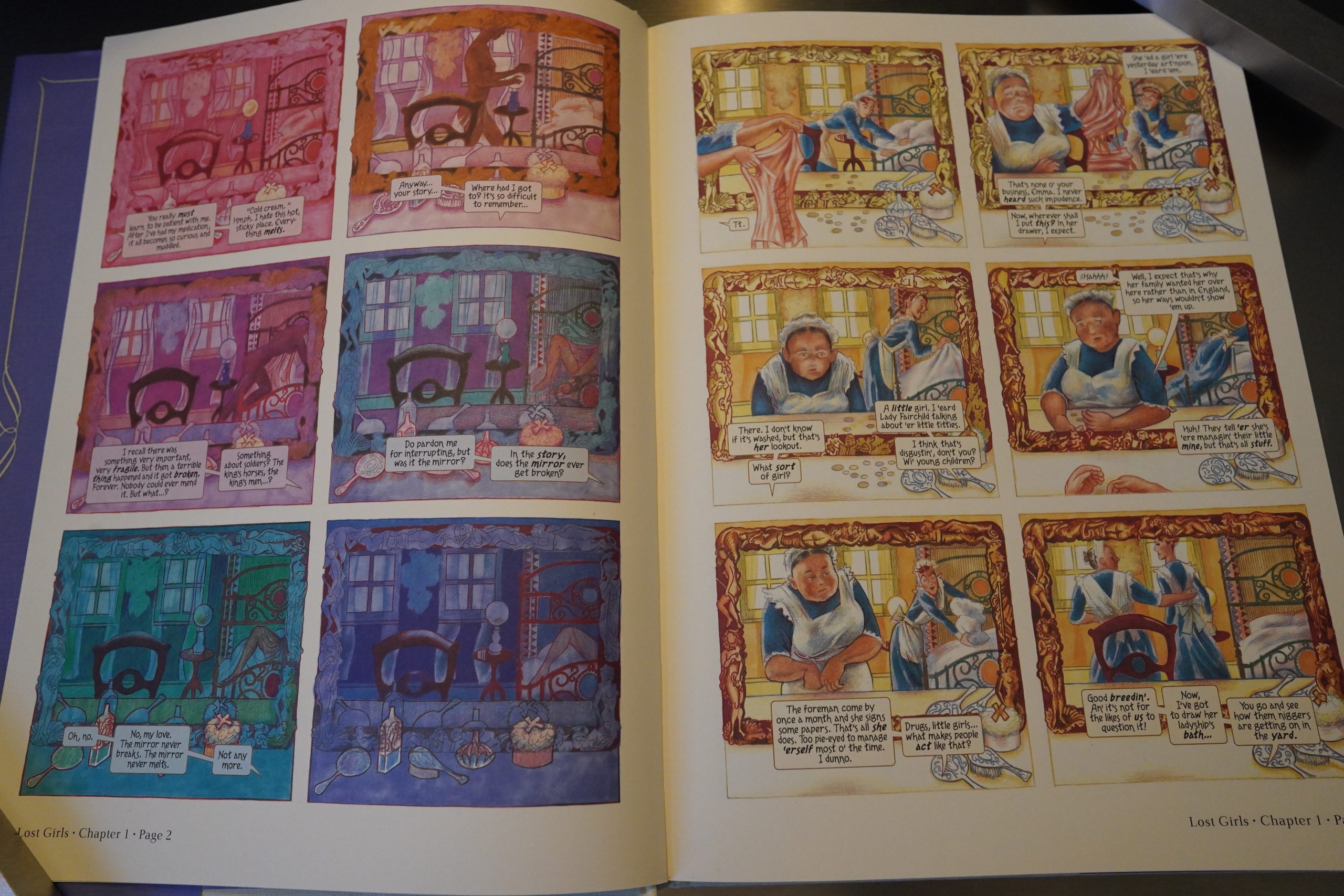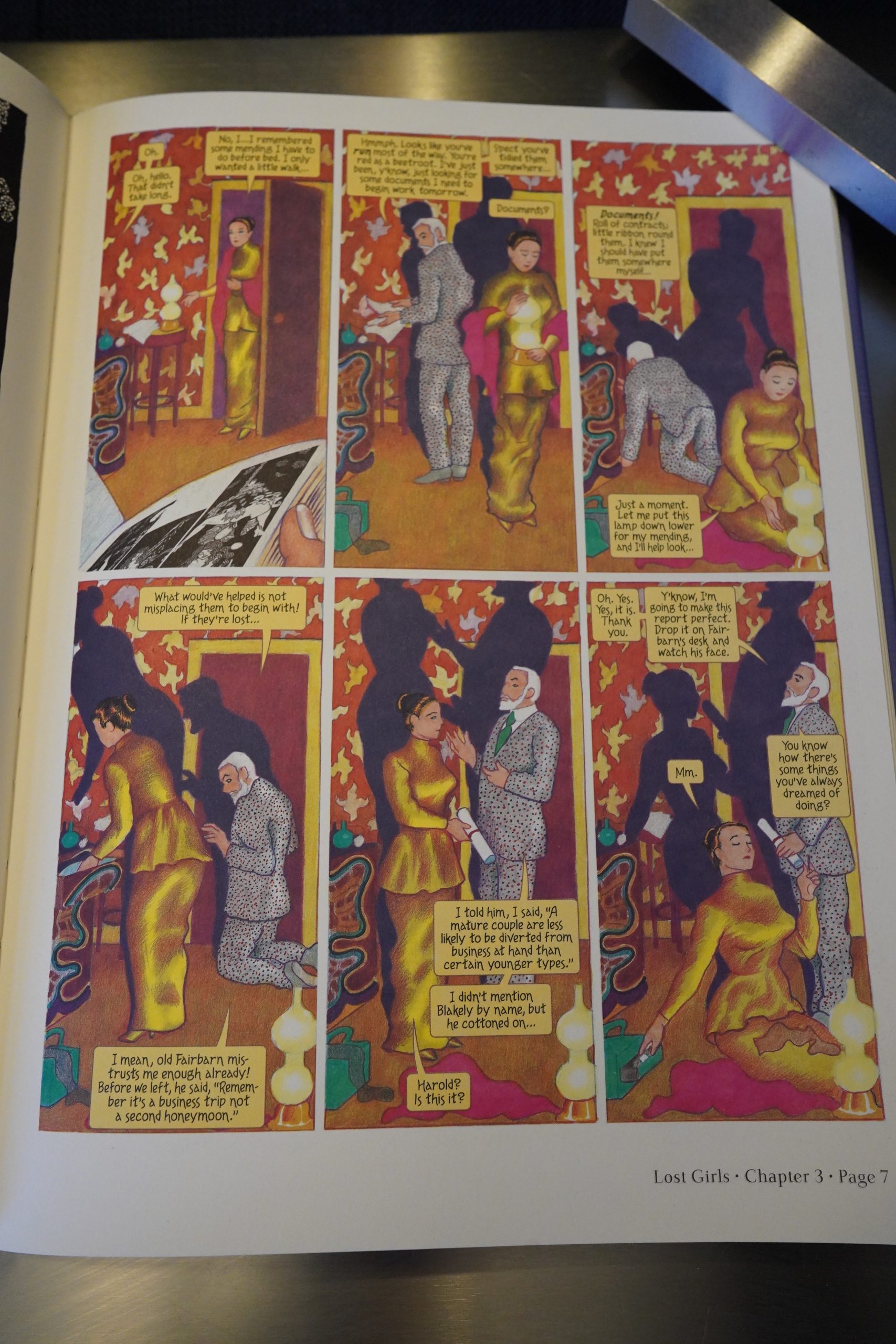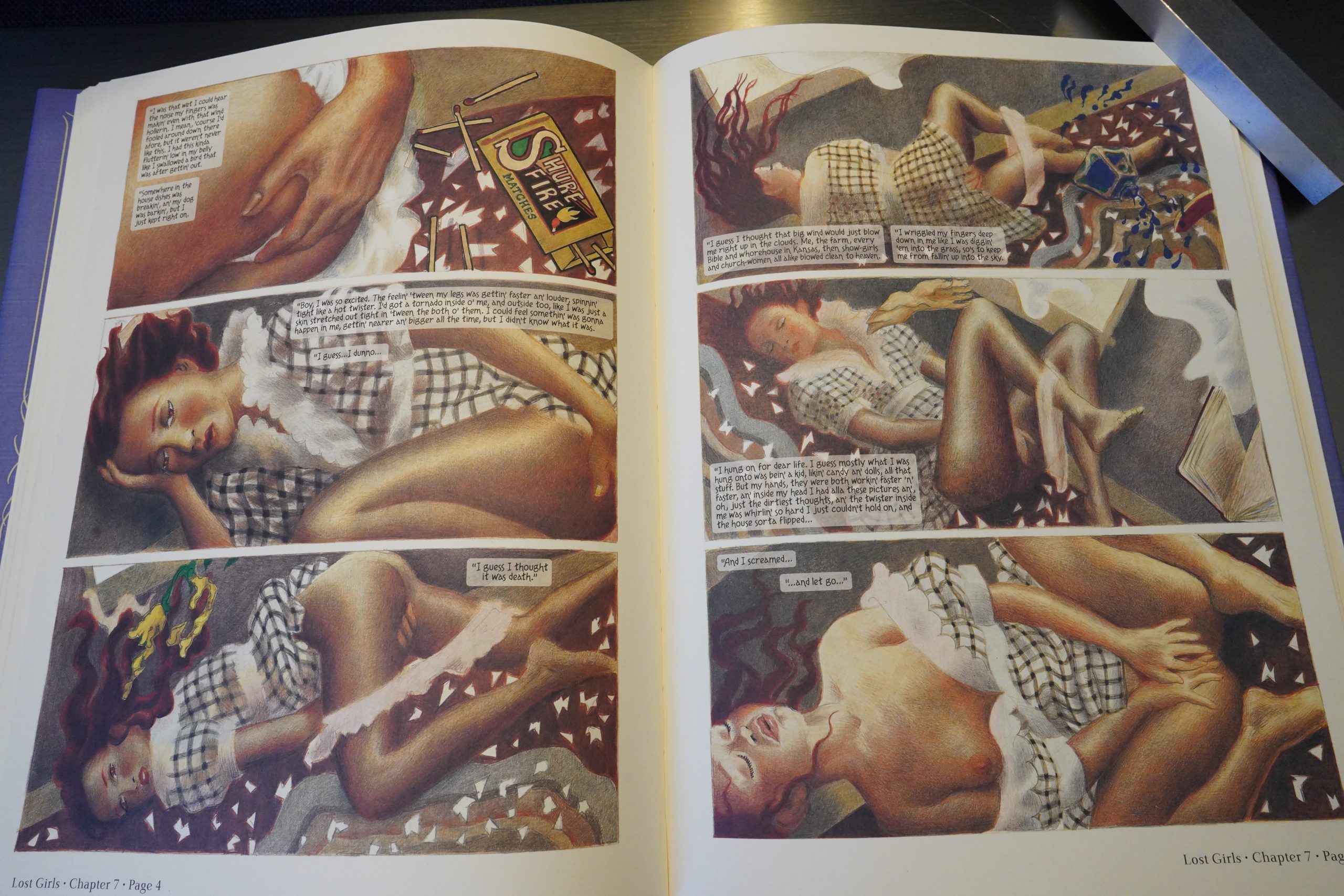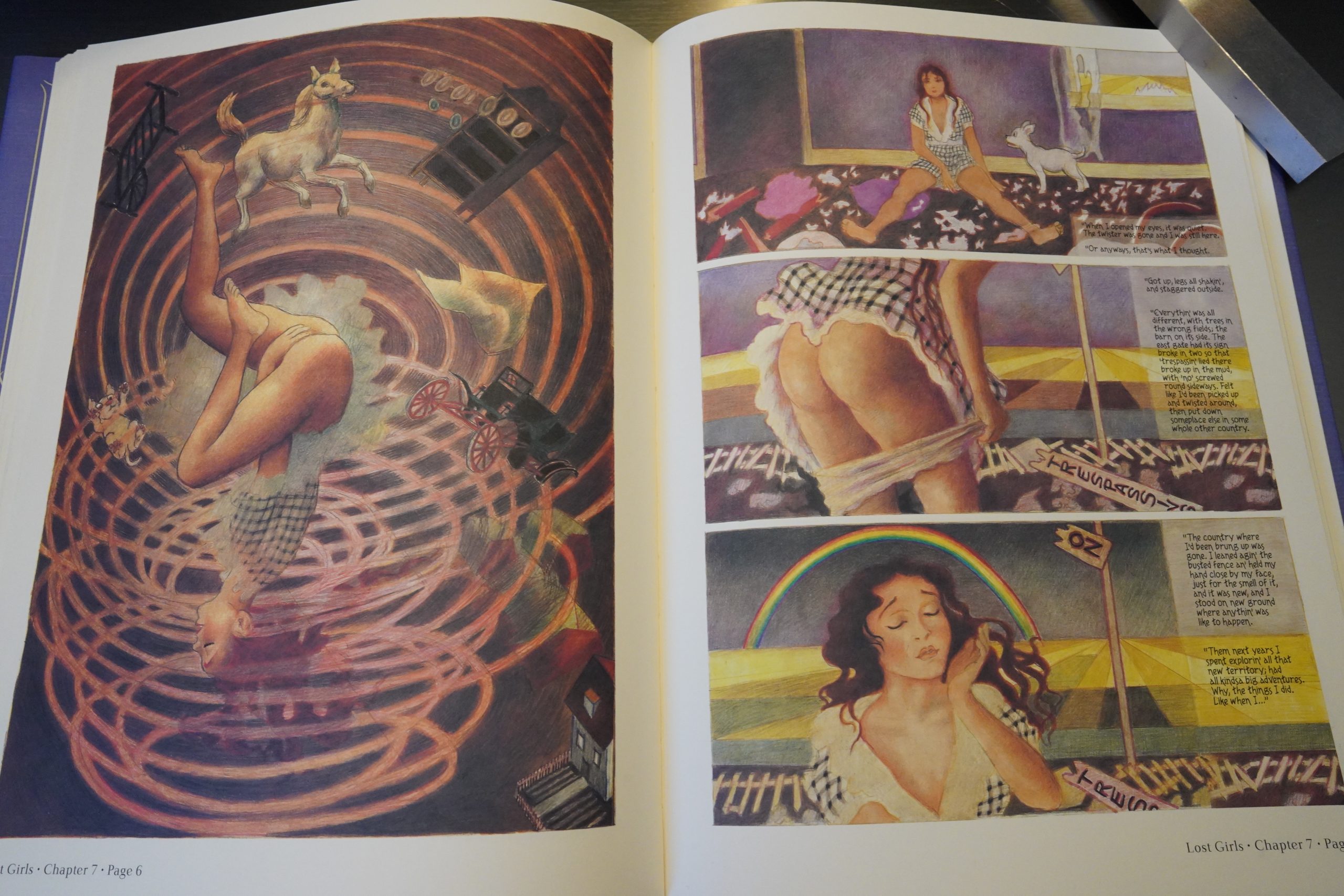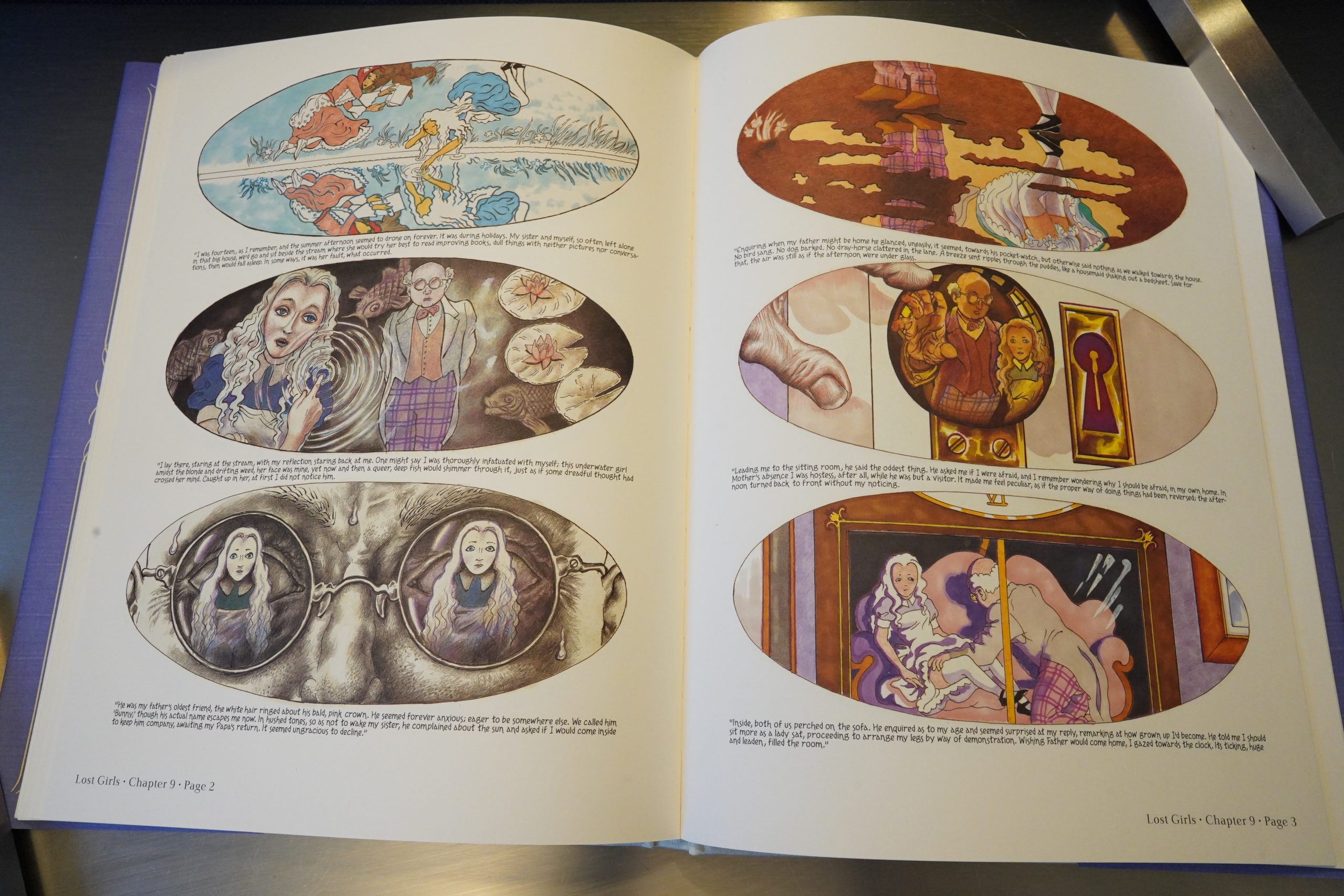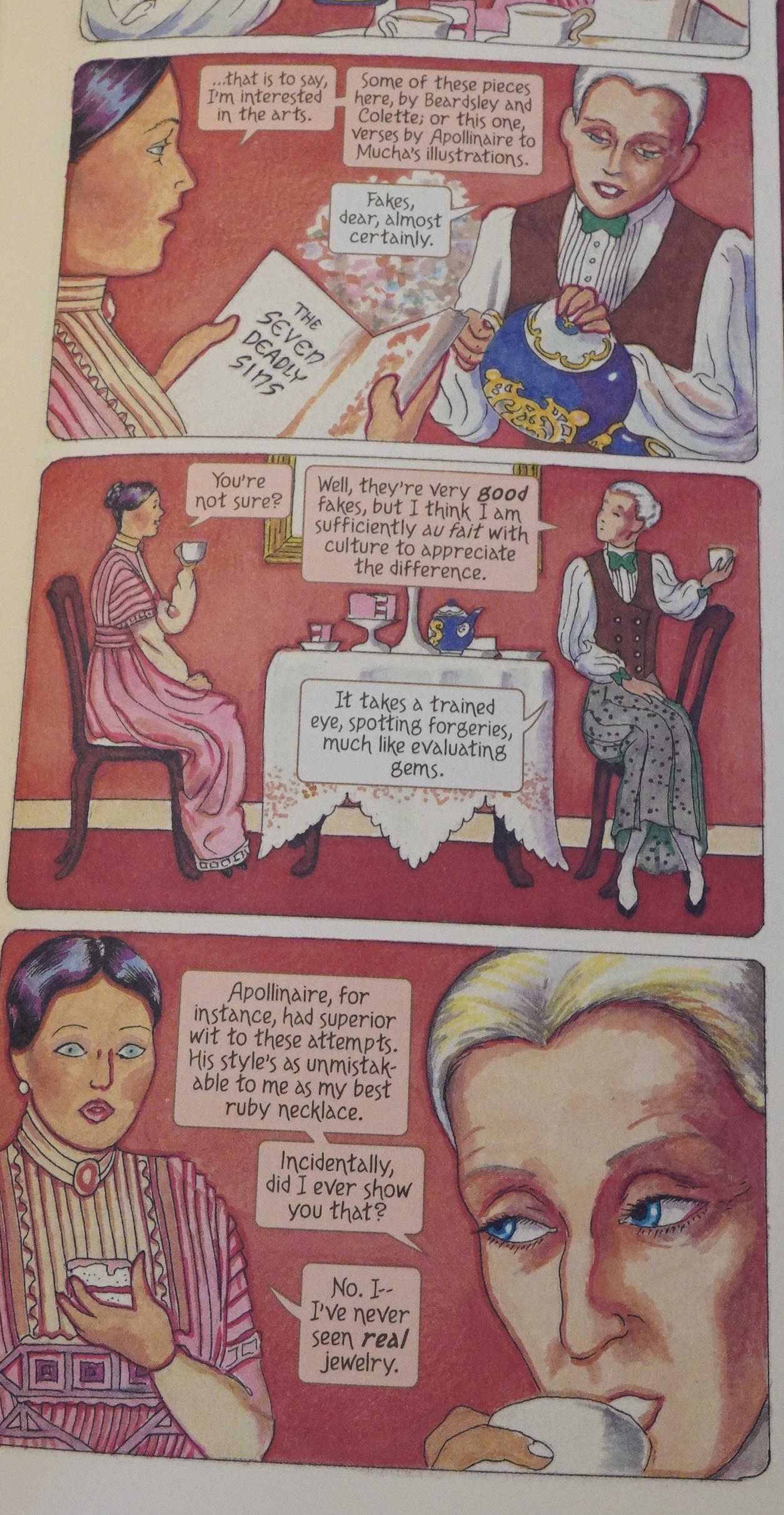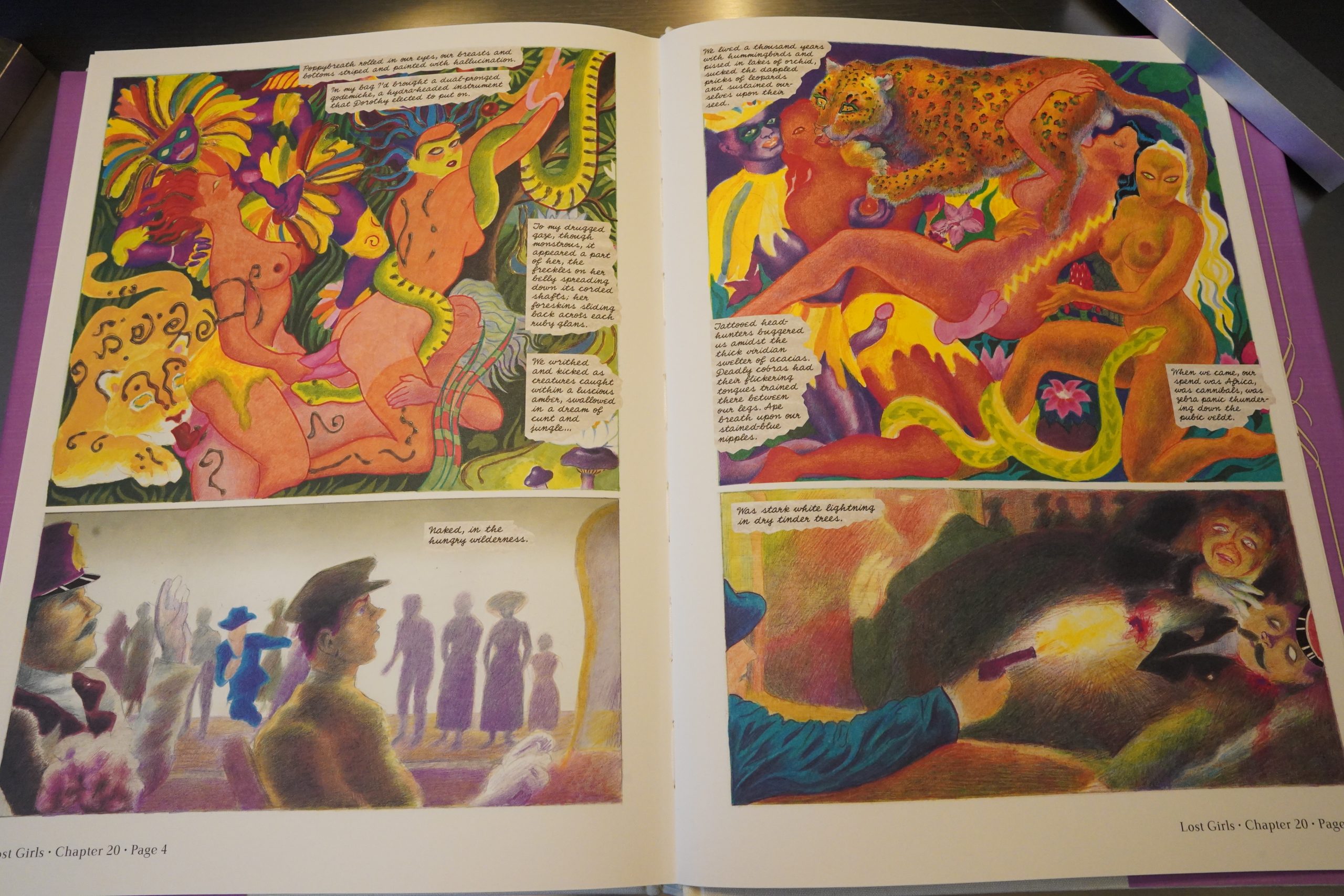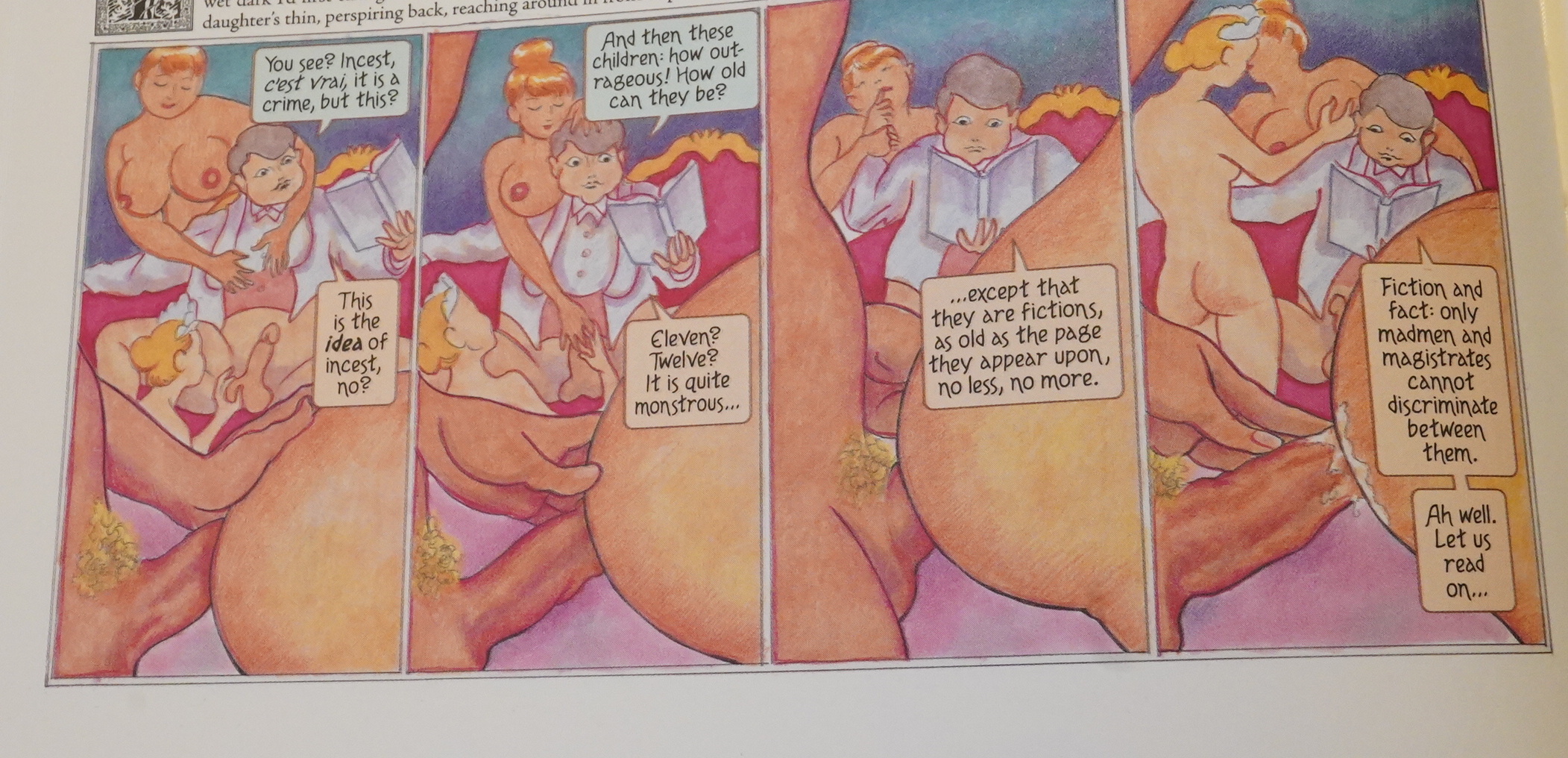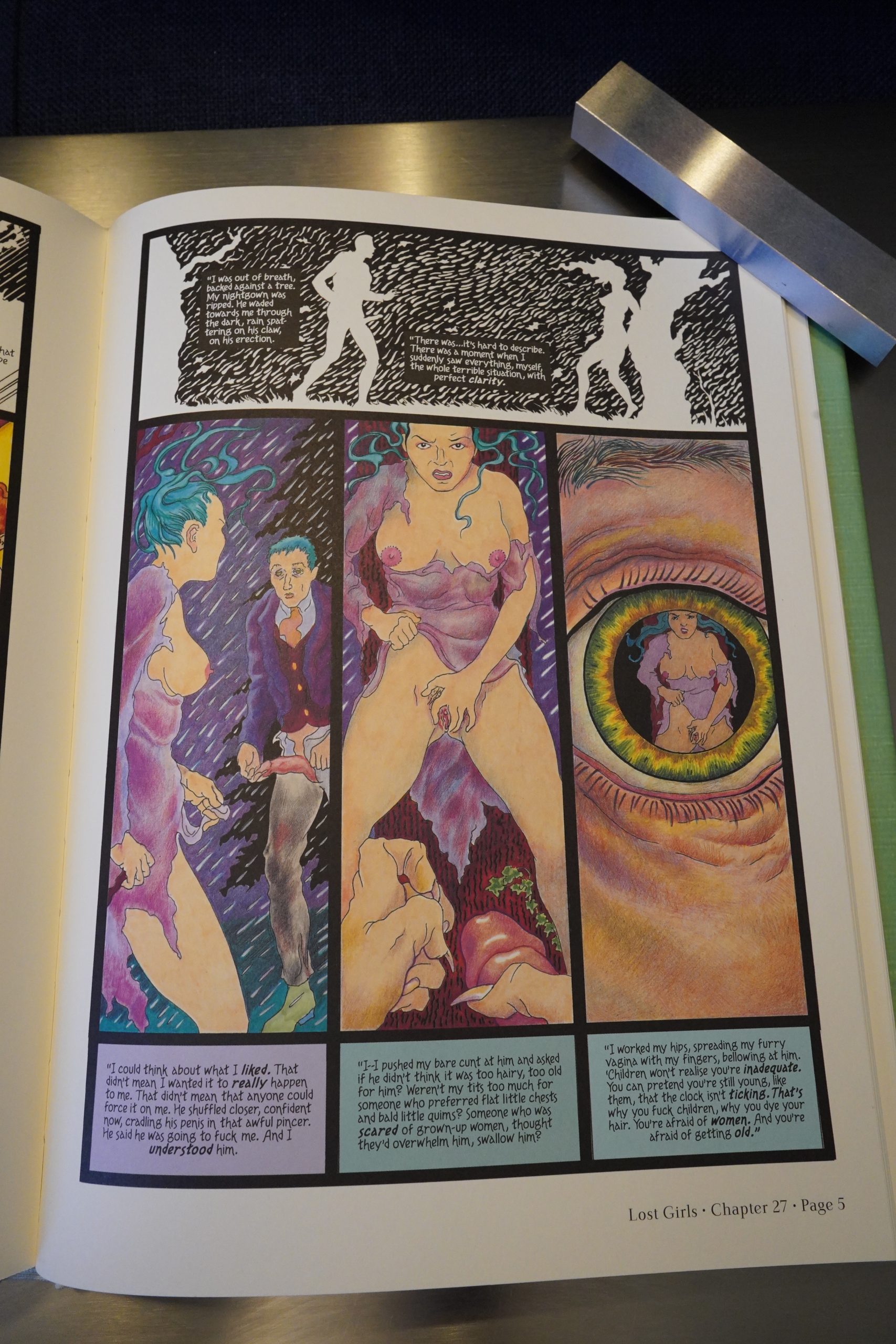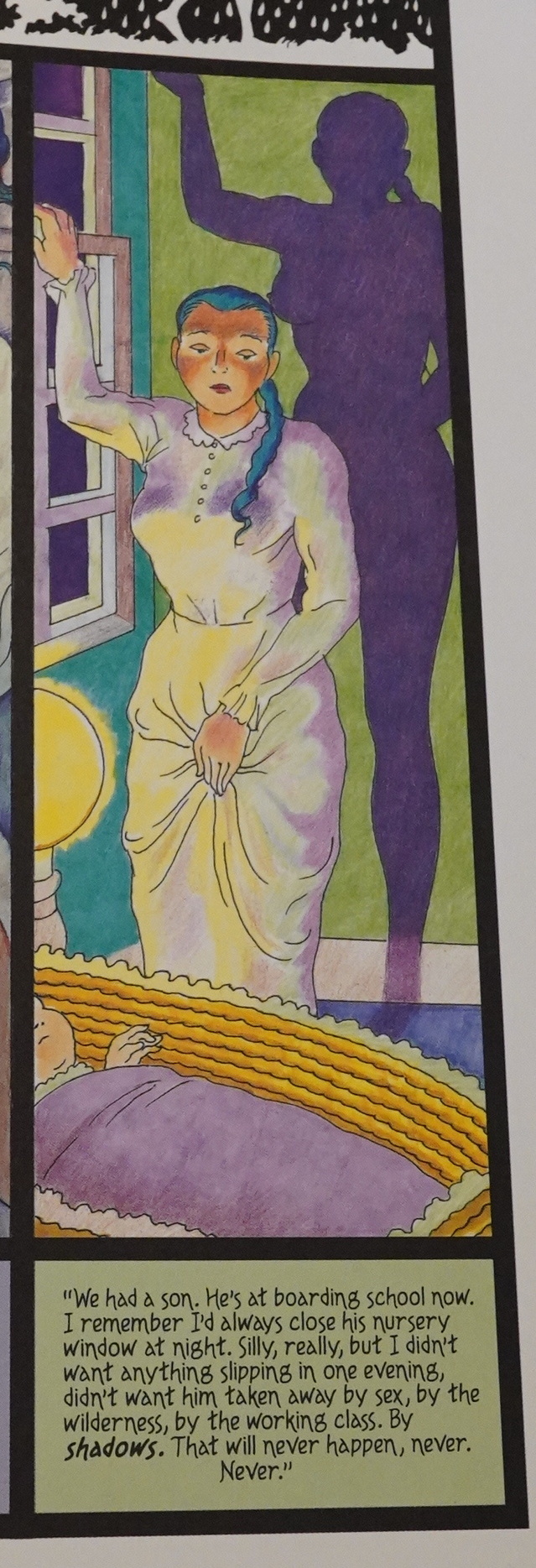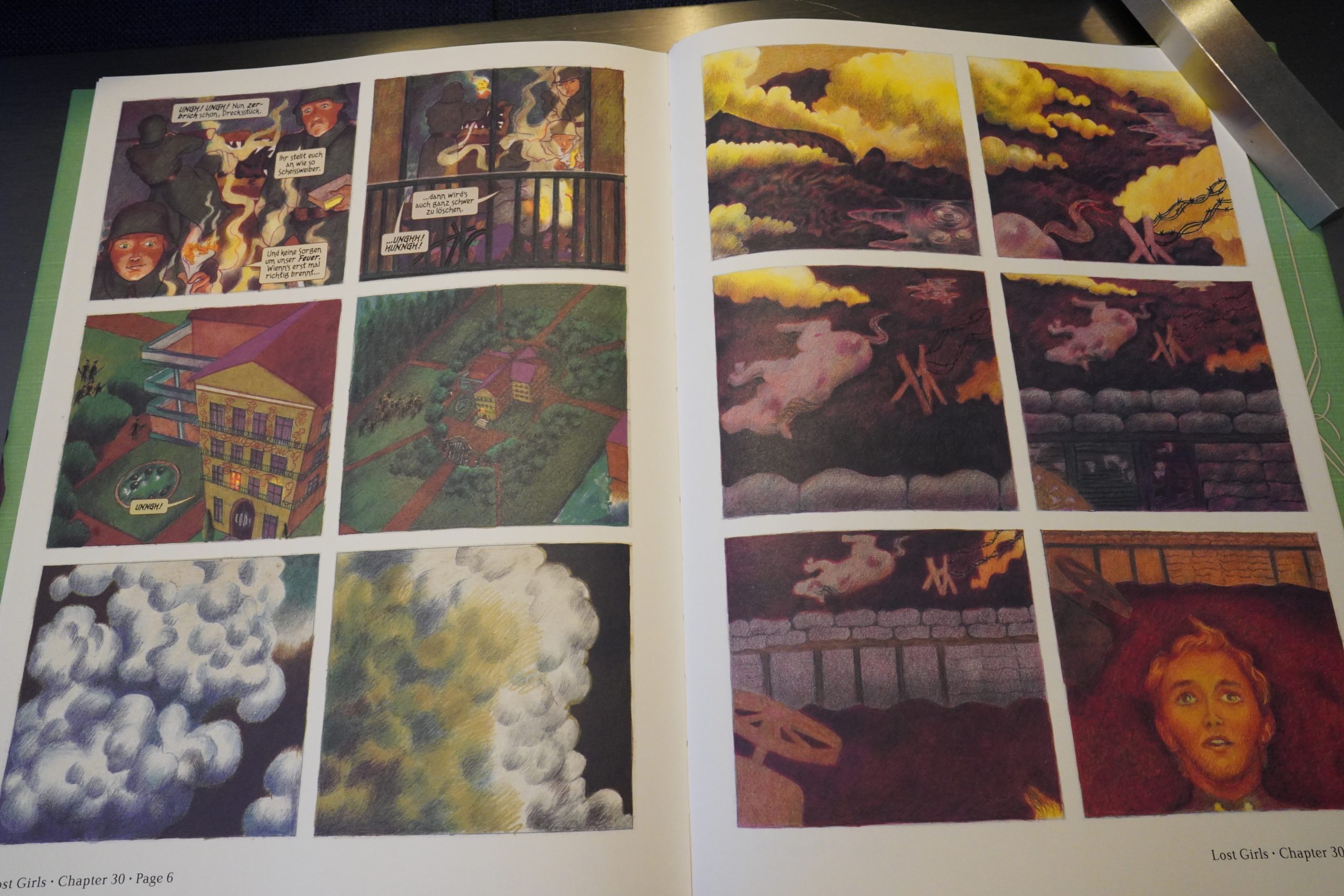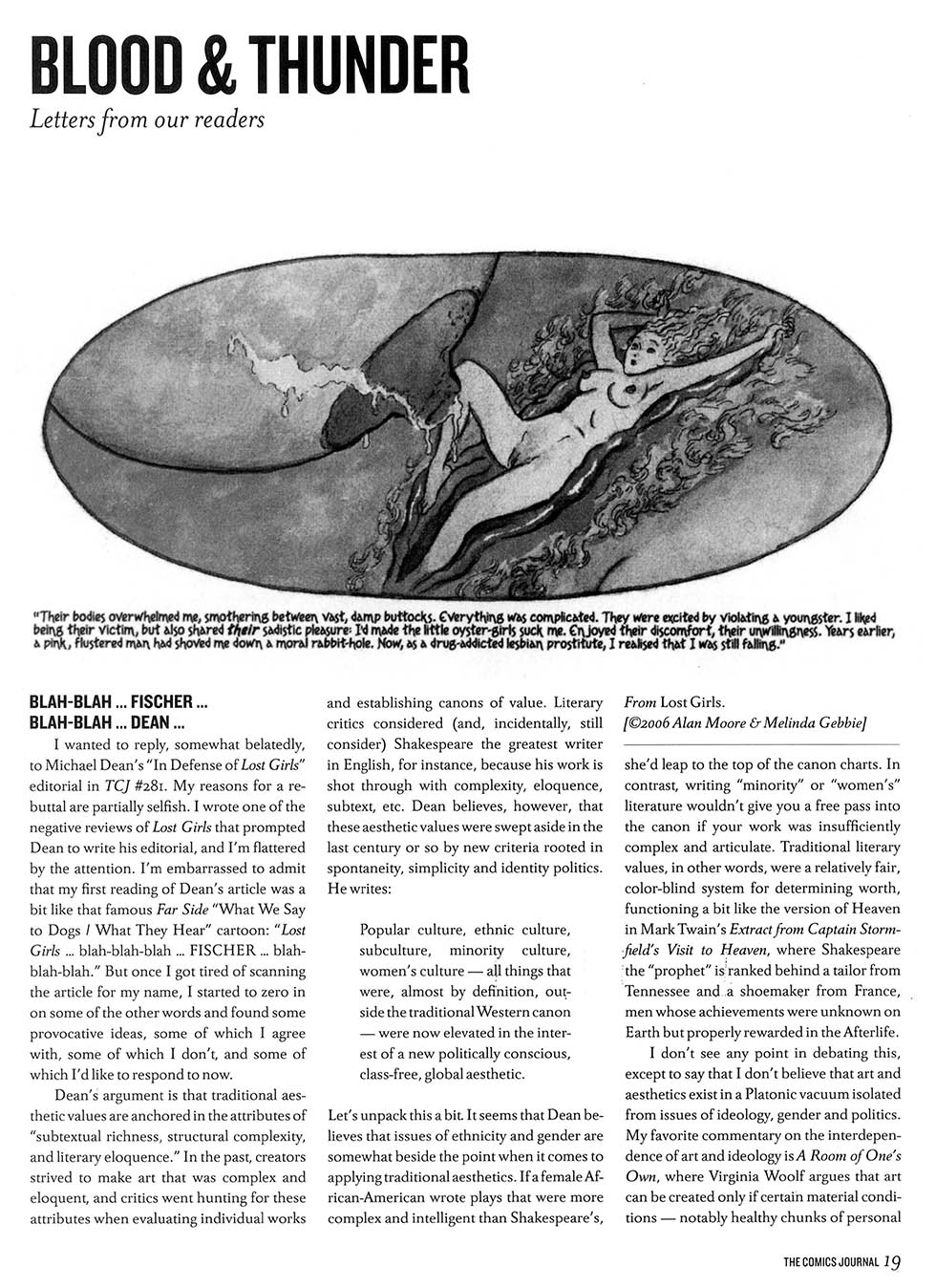Lost Girls (1995) by Alan More and Melinda Gebbie
Welp! It’s been over a month since the last time I did one of these Kitchen Sink posts… which you will not have noticed, since I had a month’s backlog, so I think I only missed one day of posting?
I’m not quite sure why I put off doing Lost Girls — I love Melinda Gebbie’s artwork, and I quite like Alan Moore’s writing. But I vaguely remember this reading a lot like a whole lot of wink-wink recaps of The Wizard of Oz/Alice in Wonderland/Peter Pan, and 1) I loathe recaps and 2) I’ve never been a fan of either the Oz books or Peter Pan (while I quite like Alice in Wonderland).
Whatever the cause, I procrastinated for a month, but if I’m ever gonna get this stupid project done, I have to get to it. *rolls up sleeves*
Oh, and I guess I should give a little content warning on this one: There are sexually explicit drawrings in this blog post, so C-w if you want to avoid those. (But I’m not snapping any of the pages that might get this blog taken down, m’kay?)
The edition of Lost Girls I have here isn’t the Kitchen Sink one, but the three-hardcover-in-a-slipcase edition from Top Shelf in 2006. The first five chapters were serialised in Taboo, and Kitchen Sink then published two issues collecting those chapters, adding two more chapters. And then stopped — Kitchen Sink hadn’t yet gone under (for the final time), so I’m not sure why the collections stopped. I remember people being surprised when the Top Shelf collection dropped: I think people assumed that it had been abandoned (like Alan Moore’s Big Numbers series).
The Top Shelf thing does everything it can to signal that it’s Serious Stuff, Not Porn At All, Mr. Customs Officer. It’s in a classy box set, weighs several kilos, and is printed on matte paper (the Taboo chapters were on shiny paper).
And it looks great! Gebbie’s colour pencils are reproduced wonderfully here.
But as is often the case, “classing it up” in the US often means “adding more”, so we get a text on each page saying “Lost Girls, Chapter 1, page 3” which just seems annoying.
This is a page that gets cited a lot — probably because it hints at sex without actually showing it, but more importantly, because it shows how “clever” Alan Moore is. Look! The shadows are having sex! While everything they say can be interpreted as double entendres! Clever!
If my eyes could roll any faster, they would.
The set consists of 30 eight page stories, and Moore and Gebbie gets a lot into each eight page stretch. Most of these stories consist of Wendy (from Peter Pan), Alice (from Alice) or Dorothy (from Oz, shown above) tell a bit of their familiar stories to the other two (who are usually masturbating at the time). But the schtick is that everything we know from the stories are actually bowdlerised versions, where the “real story”, is about the people in the stories having sex.
So Oz is a metaphor fox sex, Peter Pan is a metaphor for sex, and Alice in Wonderland? You guessed it.
Sometimes this works eerily well — like, “yeah, I could see a hurricane being a pretty good metaphor for orgasm” — but sometimes it’s kinda strained, and the “reveals” (left page above) that tells the reader “IN CASE YOU DIDN”T GET IT< THAT BIT WAS ABOUT THE HURRICANE IN OZ", which feels pretty condescending. On the other hand, perhaps Gebbie just really wanted to draw those "reveal" pages. In which case I can't blame her, because they looks pretty great. 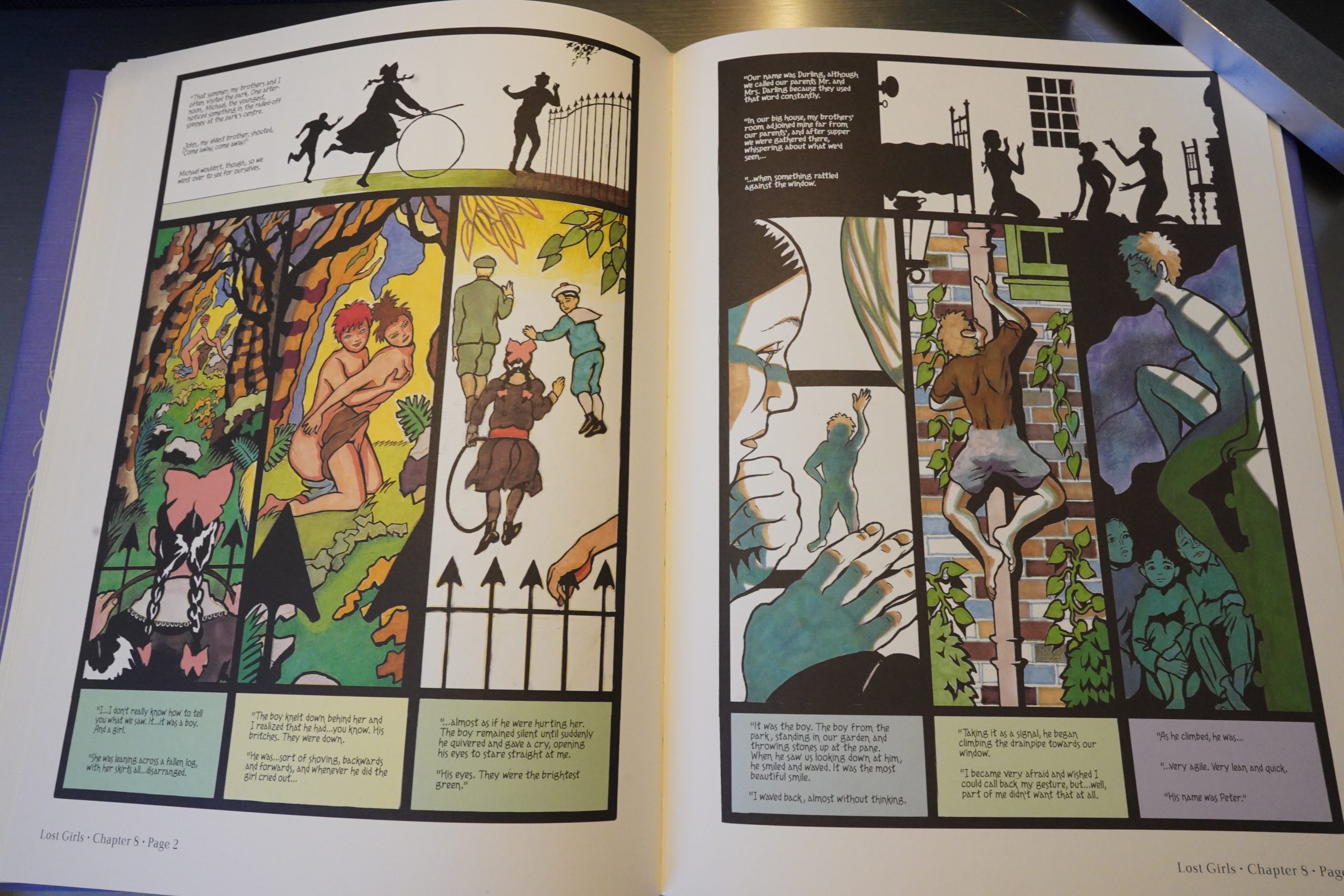
We basically get the three entire stories, but they’re told in an interleaved fashion, and usually with a distinct visual style to set the apart. So the Peter Pan bits are in this layout…
… and the Alice bits use this style.
While this is, mainly, a porn book, they bring in a lot of horrifying things, too. The book is constantly on the precipice of being a horror book, in some ways. And in other ways, it’s a pretty embarrassing book: Alice “origin story” is that she’s raped as a child by this prick, and she has an epiphany towards the end of the book that SPOILERS perhaps she’s a lesbian just because of that, and not because she’s into women.
It’s very pomo, what with the main story itself being a skewed retelling of other stories, but there’s (of course) also a book in the book (isn’t there always?) that is of unclear provenance. It’s being presented as possibly being a collection of erotic texts from famous writers, but more likely a forgery, and Moore hedges by having a character giving a critique of the book. So he gives himself the appraisal that they are “very good” but obviously not as good as if they were actually real.
Which is smart! Because the bits from this book (excerpt on the right above) are pretty leaden. And it’s a common problem when writing something about finding books/art that’s supposed to be incredibly well done. How do you work around that? If you don’t include it, it feels like a cheat, and if you do, it better be really good, otherwise the whole thing becomes totally risible. Moore, smart as he is, tells us that the “lost book” isn’t that good up front. *slow clap*
While I was in no hurry to re-read this book, I found myself enjoying it more than I expected. Gebbie’s artwork is fantastic, of course, but there’s more of a storyline than I remembered. In addition to the many stories within the story, the main setting isn’t static, either: World War I breaks out while they’re in the hotel, and war encroaches upon the third volume.
The main subject of the book is porn. Moore delivers an in-story defence of porn, which is the quite standard one…
… but then he complicates it. Oh, the layers.
The book isn’t just a series of vignettes, either — it gets gradually more and more unhinged, building up to a crescendo. It’s like the entire book is a metaphor for sex or something.
But there’s a lot of eye-roll inducing stuff here. Like Wendy unmanning a rapist by confronting him with some hard truths.
*gasp* By the working class!
And of course, the real obscenity is war.
I poke fun, but it is a good comic book. This book apparently took 15 years for Gebbie to draw, though, and I love the wilder, strange stuff she wrote herself, so I’d prefer myself she’d done more of that stuff instead. But that’s not how the markets work, so we’d probably have gotten a whole less stuff than these 240 pages, so…
IDW released an expanded version in 2019. It’s 350 pages — that’s more than a 100 pages more? I googled around to find what in those pages — sketches and interviews and essays and stuff, or a continuation of the story? I was unable to find anybody giving the dirt on the edition. INTERNET! WHY YOU SUCK!
The groundbreaking and controversial masterpiece of erotic comics, decades in the making, is now available in a sumptuous hardcover collecting all three volumes plus 32 pages of new artwork and commentary.
Well, that doesn’t help a lot. Hm… Oh, I guess the old version was more like 300 pages, not 240, because there’s a couple extra pages per eight issue story for titles and stuff.
Paul Tobin writes in The Comics Journal #184, page 53:
I APPROACHED Lost Girls with preg-
nant trepidation. It has been some time since
the name of Alan Moore has been asurefire sell
to me. Too many unfinished projects, blood-
soaked demons, shapely bad girls and untamed
felines have thrown a good deal of muck upon
the flame and tarnished the once shini ng bronze.
But since Lost Girls was a project which began
years ago, perhaps, I hoped, Moore’s muse was
still a potent one at that time. So when I picked
up Lost Girls it was with both cautious hands
and timorous hope for a book where either
character or story could anchor an ultimately
successful project. Unfortunately, even those
diffident hopes were almost immediately
dispatched. Ins,’ Girls, on any level, can Only
be considered a failure.
The basic plot of Lost Girls , by writer Alan
Moore and artist Melinda Gebbie, is the chance
meeting of three women in the opulent Hotel
Himmelgarten, located on the remote Austrian
border. The year is 1913. The three women are
the Lady Alice Fairchild, who has been ostra-
cized from her noble family due to her sexual
improprieties; Dottie Gale, an American girl
on vacation; and Mrs. Harold Potter, who is on
business vacation with her uninterested and
uninteresting husband. After the single intro-
duction of these women, sexual antics spas-
modically ensue between them and various
secondary characters. These liaisons occur
neither in story flow nor because of any actual
attraction between characters, but simply be-
cause this is supposed to be erotica, where such
things happen.
Of course, there is more to Last Girls than
this. Moore has never been the type of writer to
be content with simply telling a story. There
must be circles within circles — clues for the
astute (or at least the sighted) reader to pick up.
Presumably we are then supposed to marvel at
how wonderfully tricky a writer Moore is. In
actuality, though, these clues more often serve
as story breaks, actually tugging readers away
from the story. In Lost Girls, Moore is just a
two-bit magician, content with clichéd tricks
and obvious effects. Worse, we don’t simply
look at the created tricks, we are forced to gaze
upon the act of creating them itself. And once
the viewer is looking notat the trick, but instead
at the trapdoor on the bottom of the box, of the
magic is gone. In Lost Girls, the tricks which
dissolve what little magic there is are the women
themselves. Through various clues, Moore lets
the readers know that the women are grown up
versions of characters from famous children’s
books. The Lady Alice Fairchild is Alice of
Alice in Wonderland. Dottie Gale is Dorothy
from The Wizard ofOz and Mrs. Harold Potter
is Wendy of Peter Pan fame. The choice of
these characters seems to serve no purpose
other than Moore thought it would be neat
The Story Of these lost girls is told in chap-
ters. Chapters one through six were originally
presented within the pages of Taboo , but lwst
Girls volume one concerns itself with Only the
first three, with the first, entitled ‘The Mirror”,
focused upon Lady Fairchild.
In chapter one we see everything, in every
panel , through reflections in a mirror— through
the looking glass, if you will. The sex, the story
rHEC0.wcSJ0tJRNAL FIRING LINE ./84 FEBRUARY
and, above all, the Lady herself are presented as
very flat. Moore seems to believe that since his
own Alice is the familiar Can-oll character, the
character depth of the original is automatically
instilled within his new version. He’s simply
incorrect; not only that, it’s lazy writing. Add-
ing to the monstrous ennui of this chapter is the
mirror framing device, which becomes tedious
by panel six, at which point there are 42 more
panels of it to go.
Dottie Gale (aka Dorothy) arrives with an-
other “similar panel” motif, but soon merci-
fully abandons it. We first see her in a succes-
Sion of panels as nothing but legs wearing her
bright silver shoes. Dottie Gale is the typical
dumb American Midwestem girl usually pre-
sented in slacker literature. Despite her naivete,
within scant hours of her solo arrival she is
compliantly laying naked on the hotel’ s lawn as
Captain Rolf Bauer masturbates and ejaculates
upon her shoes. Her reaction to his apologetic
stammerings concerning his passions is a simple
“Ha Ha Ha. Well, I’m sure not in Kansas
anymore.” I saw the line coming, but still shud-
dered with its delivery.[…]
The stated goal of the projected 240 pages
Lost Girls is to create a work which rivals that
Of Crépax and other notables in the genre Of
erotica. Perhaps they’ve actually fooled them-
selves into believing they’ ve succeeded in this,
but, in reality, Moore and Gebbie have com-
bined to do little but sew colorful nude portraits
into the fabric of the emperor’ s new clothes.
I don’t think he liked it.
Craig Fisher writes in The Comics Journal #278, page 138:
Journal editor Michael Dean asked
me to participate in this critical round-
table on Alan Moore and Melinda Gebbie’s
Lost Girls, I was flattered, but also worried.
What if the Other critics had better things to
say about Lost Girls than me? so even before
reading the book, I began to think about
what hook I could give my review. I thought
itmightbe fun to write something playful and
unconventional — my inspiration was Darcy
Sullivan, who once “wrote” a review of Tom
Scioli’s ne Myth Of 8-0pus by assembling
quotes from Other writers — and I came up
With What I thought was a clever idea: I’d
frame the review like a 20-year love affair be-
tween Alan Moore and me. My opening sen-
tence could be “Alan and I started dating in
the summer Of ’83,” and then I’d segue into a
discussion Of how Moore treats sexuality in
his comics. I could even insert subsections
in the review with punny titles like “The
Anatomy Lesson” and “A Love Supreme.”
While I for the Lost Girls proofs to ar-
rive in the mail, I scanned through a stack of
Old Moore comics (even Deathblow Byblows,
which really blows), looking for phrases I
could twist into double entendres.
The proofs arrived, I read Lost Girls, and
I don’t feel like writing my review any more.
How come? One reason is that reading so
many Moore comics in a short period of time
made me realize how acute Moore’s decline
has been in the last 15 years. I still remember
the joy I felt when I bought the first issue of
Big Numbers: Moore was finally free Of DC,
finally free to pursue his obsessions (which,
back then, focused on Fibonacci numbers
rather than fictional snake gods) and write the
masterwork we all just knew he had in him.
After his publishing company Mad Love fell
apart, however, Moore walked a tightrope
between corporate comics (scripting for
— sigh — Rob Liefeld’ s Maximum and Awe-
some imprints) and more personal, alterna-
tive projects. The personal stuff, like From
Hell, ne Birth Caul and Snakes and Ladders
(all drawn by Eddie Campbell), holds up
well, although sections of all of these books
are mind-numbingly ovenvritten, a tendency
in Moore’s work that resurfaces in Lost Girls.
I also liked Supreme’s evocation Of Weis-
inger-era Superman comics. But America’s
Best Comics were, for me, anything but. Tom
Strong started out, well, strong, then quickly
spoiled; I always thought Top Ten was over-
rated: and I found Tomorrow Stories so lousy
that I actually stopped buying it after issue
five, unthinkable for someone who’d previ-
ously gotten headaches from the anticipation
he’d felt waiting for the next issue of Watch-
men. (The exception to my blanket dismissal
of ABC is Promethea, which I still like for its
wonky mysticism and extraordinary final is-
sue.) To write the “dating Alan” review, then,
I’d have to acknowledge that our relation-
ship wasn t by-making-love-i n-
the-forest-while-ingesting-psilocybin” any
more. In fact, these days it feels more like a
fatal tryst between Mr. Hyde and the Invis-
ible Man.
The other reason I abandoned my clever
review was my lack of enthusiasm for Lost
Girls itself: It feels like nothing more than
a retread of Moore’s older, more distin-
guished work. Let’s 100k, for instance, at the
structure of Lost Girls. The first five chapters
of the book introduce Lady Fairchild (the
grown-up Alice from Alice in Wonderland),
an adult Dorothy Gale from The Wizard of
Oz, and Wendy from Peter Pan, who’s now
caught in a loveless marriage with a ship
manufacturer. The three women meet at the
Hotel Himmelgarten, an Austrian establish-
ment run by the effete Monsieur Rougeur.
In Chapter 6, “Queens Together,” Alice
and Dorothy stroll off into the forest sur-
rounding the Himmelgarten and just begin
to settle into a comfortable 69 (“Y,/e must re-
semble people on a playing card,” says Alice,
who’d know) when they realize that Wendy
is watching this beast With two backs. After a
brief confrontation, Alice and Dorothy make
friends with Wendy, and the chapter ends
With Alice suggesting that the three women
“devote this afternoon to storytelling.”
From this point on, the narration Of Lost
Girlsrigidly alternates between past and pres-
ent The past events are the stories the wom-
en tell to each other, pornographic takes on
Wonderland, oz and peter pan. In Chapter
7, for instance, Dorothy describes how she
masturbated and reached orgasm for the first
time While a twister ripped apart her Kansas
farm. In contrast, the events that unfold in
present-time in Lost Girls show the decline
of traditional Europe circa 1913-14 — Chap-
ter 10 chronicles the riot accompanying the
premiere of Stravinsky’s Rite of Spring, while
in Chapter 20 the Archiduke Ferdinand gets
plugged —
or present the Himmelgarten
as a safe, sexy space briefly protected from
Europe’s collapse. (Moore’s Himmelgarten
is a direct nod to the Chateau de Silling, the
castle retreat occupied by libertines
ing the Thirty Years’ in the Marquis de
Sade’s 120 Days of Sodom.) The Top Shelf
edition of Lost Girls divides into three hard-
cover volumes of 10 chapters each, and be-
low I’ve listed how the balance between past
stories and present events plays out in each
volume. (Anyone allergic to spoilers should
skip this list.)[…]
This list makes one point clear: Lost Girls
follows an amazingly schematic Structure,
With the subject matter Of each chapter
termined as much by its place in that
ture as by the organic unfolding of the story.
In other words: Lost Girls is Watchmen, but
with lots more fucking. Six of the chapters of
Watchmen (2, 4, 6, 7 , 9 and 1 r) present us with
the story’s past; they reveal the origins Of spe-
cific heroes, and narrate the histories Of the
Minutemen and the stillborn Crimebusters.
The alternating chapters (1, 3, 5, 8, 10 and 12)
chart present-day events in the fictionalized
Watchmen world, including Rorschach’s
hunt for the Comedian’s murderer, and es-
calating nuclear gamesmanship between the
and the USSR. In a similar fashion, each
of the three volumes of Lost Girls sandwiches
stories from the past (the erotic “origins” of
Alice, Dorothy and Wendy) between pres-
ent-day chapters that chronicle apocalyptic
events (the assassination of Archduke Ferdi-
nand and the beginning of WWI).
Given that Moore has spent much of the
last decade either assembling Leagues of Ap-
propriated Characters Or “inventing” slight
variations on copyright-protected ones like
Superman and Wonder Woman, it was na-
ive Of me to expect too much originality from
the structure of Lost Girls. But the problem is
more than structural; it extends to the book’s
subject matter, where Moore’s desire to re-
write Wonderland, Oz and Peter Pan leads
to crushing boredom. Dorothy’s first flash-
back, for instance, is presented in Chapter
7, with her she-bop during the tornado. She
continues her tale in Chapter 14, “The Straw
Man,” where she seduces a farmhand with
“no thoughts an’ no imagination” and, in the
process, encourages him to develop a brain.
After I read this chapter, I was ready to throw
myself at Moore and beg, “No, no, Alan!
Please don’t make Dorothy fuck the Cow-
ardly Lion and the Tin Man and the Wizard
too! I’Vouldn’t it be wacky if she got it on with
a milkman or traveling salesman completely
unrelated to the Oz characters?” But Alan
wasn’t feeling wacky When he wrote Lost
Girls, and by halfway through volume two
I could roughly guess what was going to ocv
cur in the rest of the flashbacks. Predictable
structure, predictable subject matter read-
ing Lost Girls became a grind, entirely bereft
of thefnn I ‘d expect from either good porn or
Moore at the top of his game.[…]
A persistent rumor among alt-comics fans is
that Top Shelf needs to sell a lot of copies Of
Lost Girls, or the company will go bankrupt.
While I wish Top Shelf all the best, Lost Girls
is, alas, empty and unoriginal, and Moore
has become the Straw Man, leaving comics
none too soon and many years too late.
Sorry for quoting at length, but I thought that was a pretty good review.
Tom Crippen writes in The Comics Journal #278, page 141:
“HEY-YOH!”
If you couldn’t write a masterpiece, then
probably you couldn’t write Lost Girls ei-
ther. Still, the book is no masterpiece. Alan
Moore reports that one time he spent a
couple of weeks believing that cherubs were
the most important thing in the universe and
next his hallway was painted solid with cher-
ubS and he couldn’t figure out why he ever
wanted them there. Lost Girls is a bit like that
— kind of a wrong turn.
As genres go, pornography makes super-
hero comics 100k good. Both are builtaround
spasms of activity that apparently can’t be
left out of the action. You have to have fight
scenes, you have to have sex scenes. But at
least the fight scenes come with some mo-
tivation. The man wants to rob the jewelry
store, or the man is mad because he was im-
prisoned in the Parallax Zone. The maid who
jumps the bellboy in Book II of Lost Girls
doesn’t have a particular reason to do so. He
has less reason to take part, since he already
came a couple of minutes ago during some
fooling around With a third party. But they
go ahead anyway. Getting through Lost Girls
is like reading three volumes about people
who eat fried chicken and don’t care about
anything else. NO matter what, they’re going
to eat fried chicken, and they’re going to do it
With a chummy Rotarian air that sounds like
nothing on earth: ” My prick, he would think
Of it as an honour, Madame,” nrvlonsieur
Rougeur’s narrations and his member are
both very nice indeed.”
You have heard there’s shocking stuff
in Lost Girls: pedophilia and bestiality and
incest. Indeed there is, plenty. From inter-
views, it appears Moore conscientiously de-
cided to carry the exercise to the limit. If he
was going to do pornography, he was going
to do real pornography, not some polite liter-
ary substitute. Of course Moore believes in
consciousness-expanding everything, so he
believes in consciousness-expanding porn.
Apparently, real porn is supposed to be
transgressive” and set loose fantasies that
can never be acted upon, fantasies from the
core Of our being. TO know ourselves is to
know them too.
You start out with freeing the psyche and
you wind up with a girl jerking Off a horse.[…]
Melinda Gebbie’s art is hard to size up
because the book was sent to reviewers as
a set of black-and-white photocopies. She
drew most Of the pages with layers of col-
ored pencil; from what I remember of the
few chapters issued by Kitchen Sink years
ago, the effect is beautiful and gives the work
a lot of its body. Of course, black and white
doesn’t keep her Aubrey Beardsley pastiche
from coming through, and it’s lovely. Per-
haps best of all, Lost Girls’ panel sequenc-
ing shows Moore hasn’t lost his juggling
arm. If you want to see chapters told entirely
through reflections in a mirror on a dresser,
or see fully-clothed characters unwittingly
produce a sex scene by means of their shad-
ows, or watch many small moving bits of
plot, language, and symbol chime together
like a three-volume cuckoo clock, then Lost
Girls won’t entirely disappoint you. Alan
Moore can’t help being brilliant. It’s just that
here he’s ridiculous.
Michael Dean writes in The Comics Journal #281, page 31:
IN DEFENSE OF LOST GIRLS
by Michael Dean
If ever a book needed no defense, it is Alan
Moore and Melinda Gebbie’s Lost Girls,
which has been praised by critics and attend-
ed to by commentators and reporters from
every corner of the Internet to the most main-
stream of print, radio and television cover-
age. Print runs ofits $75 deluxe three-volume
sets have sold out again and again, allowing
Top Shelf a major sigh of relief at the success
of its gamble. Partly to guard against falling
into lockstep praise of the book and partly
because virtually all the Journal’s contribu-
tors wanted to review the book, I assigned
it to not one, but three critics. Since they
were regular reviewers for the Journal (Noah
Berlatsky, Craig Fischer and Tom Crippen),
I probably shouldn’t have been surprised
when each critic, one after the other, gave the
book thumbs down — each writer proudly
carrying on the Journal’s contrarian, icono-
clastic tradition by refusing to give Lost Girls
the free pass that every other critic would pre-
sumably give it. The result was that instead of
the Point-Counterpoint effect I had been
aiming for, we ended up with a sort of Coun-
terpoint-Counterpoint-Counterpoint
Under the circumstances, I imagine Lost
Girls artist Melinda Gebbie was a little puz-
zled to have her work included in theJournars
Best of 2006 a mere three issues after it had
been panned by a sizable percentage of the
Journal’s pool of critics. To Gebbie, it began
to look less like an honor than an ambush,
and she hesitated to give us her corrections
for the interview that appears on page 56.
The question that arises has two faces:
If Lost Girls is one of the best comics works
of 2006, then why did it get nothing but bad
rewie”.vs in theJournal, and conversely, if the
book struck out with three Journal critics,
why is it now being celebrated by the maga-
zine as one Of the best Of the year?
I’m not going to give the book a fourth
— more positive — review here. (Non-Jour-
nal-regular Kristian Williams provides that
on page 34.) Nor am I going to try to analyze
the book, because a close reading of its many
layers and themes would take more space
than this issue can spare. Instead, I’m aiming
to read the readings of the book, in order to
reflect on what has been at stake in the vari-
ous critical responses to Girls, especially
in the pages Of the Journal.
In a way, it’s easy to explain how the
same work could be panned and praised in
the Journal: The magazine is not monolithic.
Gebbie’s interview appears in this issue,
because I think Lost Girls is one of the best
works of the year, but my opinions don’t
always coincide with publisher/editor Gary
Groth’s opinions, let alone those of all the
rewiewers.Journal critics are assigned books
to revien.v because they have proven that they
can write about comics articulately, insight-
fully, and sometimes provocatively. I have
no way of knowing whether they will review
a book favorably or disparagingly.
Nevertheless, I think the three negative
critiques of Lost Girls are consistent with a
particular unified aesthetic, a set of cultural
attitudes that have been a growing presence
in the Journal and in the alt-comics commu-
nit}’ it serves. Berlatsky, Fischer and Crippen
each elucidated his own individual take on
Moore and Gebbie’s work, but it’s not hard
to identify the book’s most prominent de-
feet as seen through all three pairs of critical
eyes: Revered author Alan Moore was again
and again (and again) charged with being
the creative team’s weak link and accused of
devising a narrative that was too stultifyingly
schematic and at the same time painfully
obvious in its symbolism and overly lush
language. Feedback from Journal readers in-
dicated more agreement With the critics than
disagreement, though one noted that three
negative reviews seemed a little like overkill.
Wow, there was a lot of stuff in the Comics Journal about Lost Girls at the time…
Noah Berlatsky writes in The Comics Journal #278, page 143:
ACCEPTING PORN AS
YOUR PERSONAL SAVIORThis is a work of pornography — not
erotica — which also presents itself as a
work Of art. The graphic style is gorgeous and
distinctive, the characters have individual
personalities, and their relationships are re-
spectfully and realistically explored in a way
designed to appeal to women as well as men.
The sex is violent, complicated, straight, gay,
sadistic, very occasionally vanilla, and woven
seamlessly into the storyline. I’m talking, of
course, about Michael Manning’s Spider-
garden series.
All right, it’s my little joke — I’m review-
ing Lost Girls, just like everybody else. But
one of the things that has annoyed me about
the hype surrounding Alan Moore and
Melinda Gebbie’s book is the suggestion
— promu Igated by both authors and review-
ers — that our cultu1T is somehow starved
for aesthetically pleasing, intellectually seri-
ous stroke material. Granted, there is a lot
of crappy porn out there — but then, there
is an almost unlimited quantity of every kind
of porn out there. Underage porn? Sure.
porn with people dressed up in bunny suits?
Check. Porn created by surprisingly clever
people with humor, insight, wit and taste?
Yes, indeed, grasshopper, for the Internet is
vast, and most of it is devoted to smut. (For
one example of well-written, thoughtful and
very funny porn, check out EyeofSerpent’s
storiesonwum’.mcstories.com.) Even the use
Of pre-existing characters in compromising
positions has become common — though,
to be fair, slash fiction is fairly uncommon
in comics form, and it was, in any case, a lot
less high-profile when Moore and Gebbie
first decided to, er, fool around with Wendy,
Dorothy and Alice 15years ago. (Ifyou’re not
in the know, slash fiction is a type Of porno-
graphic fan fiction devoted to homosexual
relationships. For example, a slash story
might feature sex between Star Trews Kirk
and Spock, or between Frodo and Sam from
Lord of the Rings. Slash is overwhelmingly
written and read by heterosexual women.)
Don’t get me wrong. I liked a lot ofthings
about Lost Girls, even if it doesn’t exactly re-
invent porn as we know iL It’s an ambitious
and Often bizarre undertaking, produced
with obvious care. Moore’s decision to refer
to it as pornography rather than erotica is
admirable, and it is refreshing to see a book
with this kind of aesthetic caché and market-
ing budget present itself so directly as an aid
to orgasm, complete with contortionist sex
positions, multiple partners, full-frontal ev-
erything, and even the occasional gratuitous
slurping. In that vein, and purely as porn, it
worked for me in the utili tarian way that such
things do — there were scenes I found stimu-
lating, they occurred with relative frequency,
and the action that happened in the intervals
wasn’t so off-putting that it killed the mood.
I found the adult Wendy’s progress from
buttoned-up, repressed Victorian hausfrau
to insatiable, big-bosomed tart particularly
scorching. (Which means, I suppose, that,
like Alan Moore, I enjoy the idea of fucking
with the bourgeoisie.)
Despite its pleasures, though, there
are some serious problems with the book.
Moore and Gebbie clearly have an encyclo-
pedic knowledge of Edwardian smut, but
they have some trouble translating that into
formal mastery. Gebbie’s artwork is hard to
evaluate in the black-and-white photocopies
we were sent for review, but the color panels
I have seen are underwhelming. I admire her
ambition, and I’m all for ravishing confec-
tionary art, but Gebbie just doesn’t have the
chops to pull it off. Her drafting isn’t strong
enough to render anatomy convincingly ; nor
is it stylized enough to make up for the defi-
ciency. Her color sense is erratic — some of
the panels really work, but others are garish
and even ugly. Her designs and layouts are
0K, but hardly arresting. When Moore’s
script calls for her to mimic the styles of art-
ists like Aubrey Beardsley or John Tenniel,
her limitations become painfully obvious.
Like the art, the plot and writing both
creak audibly. Moore has always been a
heavy-handed writer, but in books like Halo
Jones and Watchmen, he had such a thorough
grasp on the genre material that it didn’t mat-
ter. At his best, even his clumsiness takes on
meaning, irony and resonance — the pirate
sequence in Watchman, for example, is both
ridiculously over the top and cool as hell, just
like the pulp masterpieces it draws on.
There are great moments in Lost Girls,
too: I love the scene where Wendy says good-
bye to her husband from an upper-story win-
dow; he thinks she’s wailing in despair at his
departure, when actually a bellhop is fuck-
ing her from behind. In general, though,
throughout the book, Moore seems ever so
slightly — well, lost The idea of sexualizing
famous children’s stories is a good one: I
certainly found the transformations in the
Alice tales weirdly erotic when I was a kid.
Moore’s follow-through, however, is only
sporadically successful. The Jabberwocky
as a giant penis is funny —
but it’s ruined
when Moore has to tell us that it’s going to
jab Alice. Dorothy masturbating while the
tornado hits is 0K; the labored metaphors
that transform her subsequent lovers into
the scarecrow, lion, and tin woodsman, on
the other hand, wander dangerously close
to the earnest pretension of literary fiction.
In fact, much of Dorothy’s dialogue sounds
like it was written in a college creative-writ-
ing workshop by a Reynolds price wannabe.
One colorful, earthy metaphor per page is
plenty, thank you very much.[…]
Perhaps Moore’s most focused discus-
Sion Of the damaging possibilities Of erotic
narratives involves Wendy. After fantasizing
about sex with a dangerous child molester
(Captain Hook), she semi-unconsciously
seeks him out, and is almost killed as a result.
In Faulkner’s novels, this sort Of collabora-
tion between victimizer and victim is a recur-
ring theme, and is used to raise questions
about how our dreams, identities and des-
tinies are attached to cultural expectations
that we often can’t control, even when we
recognize them. Led to the brink of such a
depressing insight, Moore backpedals fran-
tically, assuring us that Wendy’s real nemesis
is not her fantasy, per se, but rather her mis-
guided feeling Of responsibility for it This
is a big fat cop-out, and the immediately fol-
lowing scene, wherein Wendy scares off the
rapist by thrusting her cunt at him, was for
me the least convincing in the whole book,
and perhaps the only one that felt genuinely
exploitative.
This failure of nerve is emblematic of the
book as a whole. Moore and Gebbie make
extravagant claims for pornography, but
(or perhaps because) they don’t really seem
to have faith in the genre. Do readers really
need to be constantly assured that the-fre
fighting The Man and/or finding themselves
in order for it to be 0K to read a book with
explicit sex in it? porn has some ugly
tions, but so do most genres and mediums,
from the police State paranoia Of superhe-
roes, to the militarism Of science fiction, to
the casual disregard Of life in mystery novels.
to, for that matter, the gushy disempower-
ment of romance. It would be a surprise if
genre conventions weren’t bound up with
such implications, considering that all are
part and parcel of a reality, which is, after all,
imperfect. Despite what some critics of porn
might tell you, that’s not a reason to Stop
imagining (as if such a thing were possible),
or to endorse censorship, or even to wallow
in guilt. But it is something to think about
before you ram a dildo up your ass and
it freedom.
Non-comics media seem to like the book:
In fact, as the shadow of war engulfs the Himmelgarten, Lost Girls reveals itself to be an elegy for lost innocence. Rougeur and his increasingly vulnerable guests demonstrate that they are only too well aware of the difference between pornography and reality. “Fiction and fact: only madmen and magistrates cannot discriminate between them,” he says, before disappearing into the night. Lost Girls, despite its sometimes over-explicit philosophising, is ultimately a humane and seductive defence of the inviolable right to dream.
See?
Lost Girls is a bittersweet, beautiful, exhaustive, problematic, occasionally exhausting work. It succeeded for me wonderfully as a true graphic novel. If it failed for me, it was as smut. The book, at least in large black-and-white photocopy form, was not a one-handed read. It was too heady and strange to appreciate or to experience on a visceral level. (Your mileage may vary; porn is, after all, personal.)
I have also overlooked an interesting point Neil Gaiman raised in a recent review of Lost Girls (Neil suggested you read the book slowly, taking a break between each of the chapters to let the story settle – and he has a good point, it can be overwhelming particularly by the time you reach the third volume.)
This is the one hundred and ninety-first post in the Entire Kitchen Sink blog series.

